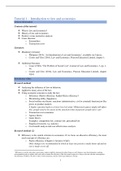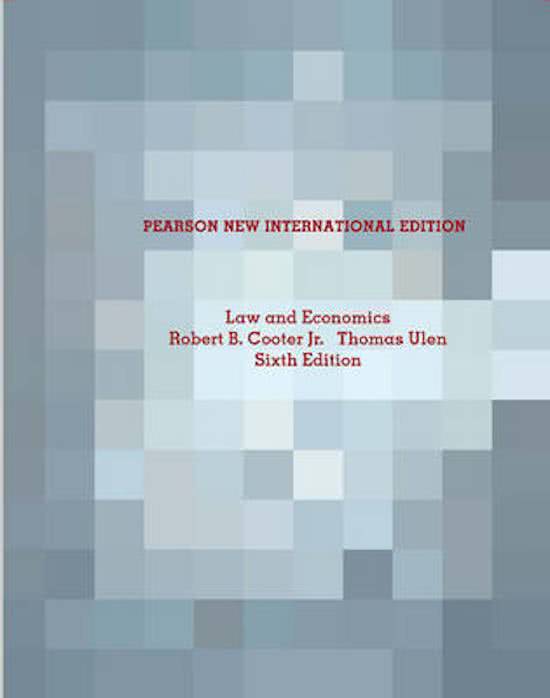Tutorial 1 – Introduction to law and economics
General information
Contents of this tutorial:
❖ What is law and economics?
❖ History of law and economics
❖ Positive versus normative analysis
❖ Coase theorem:
o Externalities
o Transaction costs
Literature:
❖ Mandatory literature
o Philipsen (2019), ‘An Introduction to Law and Economics’, available via Canvas;
o Cooter and Ulen (2016), Law and Economics, Pearson Education Limited, chapter 1;
❖ Additional literature
o Coase (1960), “The Problem of Social Cost”, Journal of Law and Economics, 3, pp. 1-
44;
o Cooter and Ulen (2016), Law and Economics, Pearson Education Limited, chapter
3(§4).
Introductory slides
Research methods
❖ Analyzing the influence of law on behavior;
❖ Applied to many areas of the law;
❖ Using economic concepts to study the law;
o Efficiency (Pareto efficiency, Kaldor-Hicks efficiency)1
o Maximizing utility (happiness)
o Social welfare rice theory: sanctions (administrative, civil or criminal) function just like
prices in product markets
A higher sanction leads to a lower level of crime? Behavioral aspects might still affect
this: people need to be aware of the sanction/crime of passion/ people don’t care
o Transaction cost economics
o Agency theory
o Game theory
Examples: competition law, contract law, procedural law
o Empirical research, e.g. statistics
o Cost benefit analysis and cost effectiveness analysis.
Research methods (2)
❖ Efficiency is the central criterion in economics. If we focus on allocative efficiency, the most
used concepts of efficiency are:
o Pareto efficiency (Chapter 2, Section 2 C&U)
Only changes are recommended in which at least one person is made better off and no
one is made worse off
1
Efficiency is not the only policy goal, policy makers might be interested in other things as well (fairness, non-discrimination, reaching
environmental goals no matter what cost (and no matter the efficiency). But the lecturer argues it is always relevant what the consequences
for efficiency would be. We don’t want to waste resources, and we want to get ahead as a society.
1
, o Kaldor-Hicks efficiency (Chapter 2, Section 9c C&U)
Changes are recommended if the gainers gain more than the losers lose (potential
Pareto improvements)
NB: note that this can be compared to a cost-benefit analysis
Research methods (3)
❖ Positive versus normative analysis
o Describing/explaining versus setting efficiency as a goal
❖ Different schools of thought
o Ex: Chicago, Yale (stronger need to regulate), Public Choice (political economy: how
politicians, voters and lobby groups behave = more skeptical view on what regulation
can do. Not always designed in the interest of society: but to serve certain groups),
behavioral
❖ The role of assumptions
o For example: rational choice and (the role of) perfect information (do people have all
the information? Are they aware of the current law?)2
❖ Reply to ex ante criticism from lawyers
o (Over)simplified models? (normative versus descriptive)
o Liberal / right-wing approach?
o Economics is only about money
▪ Economics focuses on social utility. This is broader than money. But they
sometimes do try to quantify things with money.
History of L&E (1)
❖ “Old” law and economics
o Until late 1950s
o Economists were asked to answer the questions defined by lawyers
o In areas of ‘economic law’, such as:
▪ Competition law (US: Sherman Antitrust Act 1890)
▪ Regulation of industry sectors
▪ Tax-related issues
▪ In court: determination of monetary damages
History of L&E (2)
❖ “New” law and economics
o Examples: contracts, torts, criminal law, family law, law and economic growth, etc.
o Fast developments in United States since 1960s
▪ At universities, in court and in politics
▪ Since 1980s in EU and rest of the world
o Some famous scholars, textbooks and journals
▪ Richard Posner, Guido Calabresi, Steven Shavell, etc.
▪ Books translated into Chinese (and other languages): Cooter & Ulen, Posner,
Faure, …
▪ Specialized journals: JLE, JLS, IRLE, EJLE, ALER, JCLE, etc.
o Nobel prize winners
▪ Ex: Ronald Coase (1991), Gary Becker (1992), James Buchanan (public choice,
1986
2
Economists would rather have there to be more information than less. Unless the information is confusing or wrong.
2






